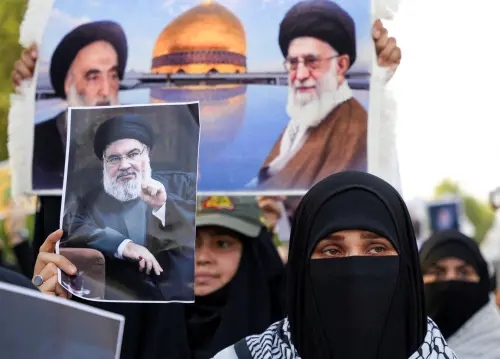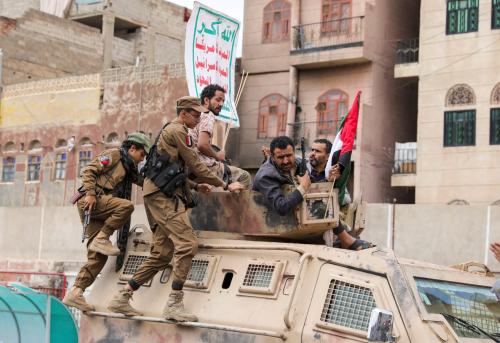In an autumn rite of passage that has become as predictable as the start of school and the changing of the leaves, this week has seen the launch of the Iranian government’s annual American charm offensive, as senior officials began arriving in New York for the United Nations General Assembly meetings. This year, as last, Tehran’s typical U.S. agenda of speeches, media appearances, gala dinners and other festivities is amplified by intense talks on the nuclear issue.
However, in contrast to last fall, when Iran’s UNGA activities seemed to herald a historic breakthrough on the nuclear impasse and even, perhaps, on the bilateral estrangement, the mood has dampened significantly. The stalemated nuclear negotiations have replaced anticipation with anxiety. The flurry of bilateral and multilateral discussions that will take place around this year’s UNGA will determine if a comprehensive nuclear accord can be achieved. This increasingly looks to be a make-or-break moment for diplomacy with Tehran.
As New Yorkers know all too well, the annual UNGA meetings transform the city into a carnival of world leaders and motorcades. But for Iran, the gatherings inevitably assume outsized significance, offering a rare opportunity for the country’s leadership to occupy the world stage from its adversary’s home turf.
During his own eight-year tenure as president, Ayatollah Ali Khamenei — who now serves as Iran’s supreme leader — made the New York trip only once, a 1987 visit that happened to coincide with a U.S. raid (and subsequent destruction) of an Iranian mine-laying ship in the Gulf. During the same session, American efforts to win a UN Security Council arms embargo on Iran ended with a statement by the permanent five Security Council members threatening sanctions unless Tehran accepted a cease-fire with Iraq. Needless to say, it was not a particularly amicable visit.
Another decade passed before Iranian leaders began contemplating a return to UNGA. Reformist president Mohammad Khatami’s multiple speeches in New York, where he promoted his vision of a ‘dialogue among civilizations’ helped energize his embattled supporters at home and won Iran new respectability in the international community. Khatami’s hard-line successor, Mahmoud Ahmadinejad, astutely recognized the public-relations bonanza offered by UNGA, and over the course of his two terms in office managed to use his annual New York bully pulpit to provoke offense, outrage and ridicule among Iranians and the world.
Rouhani’s maiden American voyage last year came on the heels of his unexpected election. It was preceded by a well-scripted drumbeat of signals from Iran, such as the release of several prominent political prisoners, innovative Twitter diplomacy by Rouhani and his foreign minister, Mohammad Javad Zarif, and a conciliatory Washington Post op-ed piece penned by the new president.
The preparations paid off; the 2013 UNGA saw a series of unprecedented overtures between Washington and Tehran, including a bilateral discussion among the Iranian and American foreign ministers and a telephone conversation between the two countries’ presidents. Although secret talks were already well underway, the dialogue that took place on the sidelines of UNGA provided an official imprimatur for the newly revitalized process, as well as significant momentum toward hammering out the November 2013 interim deal.
This time around, however, with the deadline for concluding a final agreement only two months away, the mood is decidedly downbeat. Even after a year of serious and somewhat productive nuclear talks, the core issue of Iranian enrichment capabilities remains unresolved, and all available evidence suggests that the Supreme Leader has dug in his heels. From the start, both sides understood enrichment would prove one of the toughest issues to resolve; however, Tehran’s unwillingness to contemplate any reduction in its current enrichment capacity undercuts the implicit bargain undertaken last November, in which Washington backed away from its maximalist position on enrichment in expectation that Tehran would do the same.
UNGA will provide plenty of opportunity for working through these and other differences, but a creeping pessimism has infected even the biggest boosters of diplomacy with Iran. If Khamenei were prepared to compromise, the deal would already be done; Iran gains no real leverage from the perpetuation of severe multilateral sanctions that have eroded its economy. The alternatives to a diplomatic breakthrough remain profoundly unattractive for all sides. However, unless the discussions over the course of the next few weeks generate a quantum leap forward on the essence of this dispute — Iran’s proximity to nuclear breakout — watch for the debate to shift markedly over the course of October.
Reflecting the prevailing cynicism, this year’s UNGA endeavors have included little preemptive Iranian fanfare to smooth its delegation’s U.S. welcome. Instead of happy homecomings for imprisoned dissidents, this year’s visit was preceded by the announcement that a group of young Iranians who filmed themselves dancing to the pop song “Happy” had been sentenced to lashes and jail terms. Zarif’s Twitter account has been silent for months, and Rouhani only publicly confirmed his decision to travel to New York earlier this week. And — so far — the Obama administration has wisely refrained from fueling the kind of breathless speculation about the possibilities for a presidential rendezvous that some U.S. officials indulged in last year.
Still, the show must go on. A bid to join the Rouhani revelry remains a hot ticket, and even if Iran’s standard public relations juggernaut seems a bit stale, half the American punditocracy will line up to hear Zarif’s justification for the two-month detention of an Iranian-American journalist as a purely internal matter. (Not surprisingly, he has yet to be asked about any other imprisoned dual nationals, such as former Marine Amir Hekmati who has now spent more than three years in Iranian prisons on trumped-up charges.) And the regional context provides a convenient distraction for the Iranians’ audiences, as the rising threat posed by the dystopian furies of extremist violence in the Middle East overshadows the world’s persistent concerns about Iran’s nuclear ambitions.
Meanwhile, the real action will unfold off-stage, among the teams of negotiators seeking to hammer out a formula for ending the impasse over Iran’s nuclear program. Everything else is a sideshow.


Commentary
The Boys Are Back in Town: Iran’s Annual Charm Offensive Begins Amidst Fading Hopes for a Deal
September 19, 2014